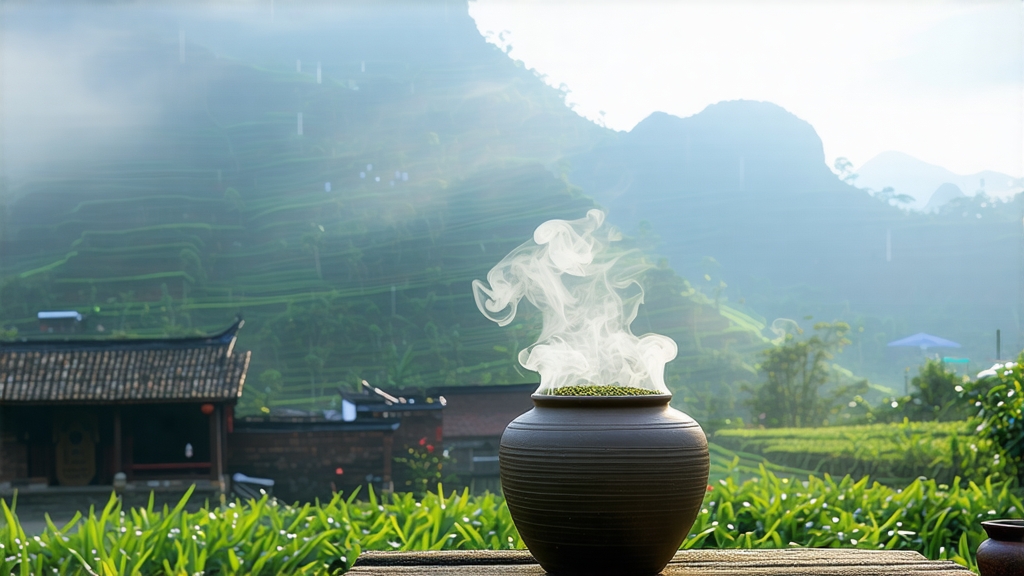
Tucked away in the humid, karst-pocked mountains of southern China’s Guangxi Zhuang Autonomous Region, Liu Bao (literally “Six Forts”) is the quietest celebrity of the dark-tea family. While Pu-erh hoards the limelight, Liu Bao has spent four centuries perfecting the art of subtlety—an art that begins with a leaf, a basket, and the patience of mountain microbes. To international drinkers who equate “black tea” with the British breakfast cup, Liu Bao offers a gentle correction: here, darkness is not bitterness but depth, not heaviness but resonance.
History: From Border Garrison to Maritime Silk Road
The name Liu Bao refers to the six defensive forts built during the Ming dynasty along the trade route between Guangxi and Guangdong. Caravans carrying Yao and Zhuang medicinal herbs stopped at these forts to barter for salt and tea. Local farmers discovered that the large-leaf Assamica varietal growing wild on the limestone slopes could withstand long journeys if lightly steamed, basket-pressed, and left to ferment in the humid air. By the Qing Qianlong era (1736–1795), Liu Bao was listed as one of the 24 tribute teas presented to the imperial court; emissaries praised its ability to “cut grease and awaken the stomach” after the Manchu banquets of roast lamb and buttered tea.
The tea truly went global when it boarded the “tea clippers” of the 19th century. Dockworkers in Singapore and Kuala Lumpur noticed that the bamboo-wrapped baskets arrived smelling of damp bark and dried longan; coolies drank it to prevent malaria, tin-mine bosses drank it to sober up, and Peranakan matriarchs stewed it with rock sugar as a hangover cure. Thus Liu Bao quietly embedded itself in the culinary memory of Southeast Asia decades before Pu-erh ever appeared on a Hong Kong dim-sum cart.
Terroir & Leaf: Where Limestone Meets Microbe
Guangxi’s subtropical monsoon climate delivers 1,600 mm of rain annually; the karst bedrock filters the water into mineral-rich springs that feed the tea gardens. The indigenous Dayezhong (large-leaf) cultivar develops leaves as broad as a farmer’s palm, thick cuticles storing sugars that later feed the microbial consortia. Spring picking follows the lunar calendar: one bud and three leaves plucked before Grain Rain (around 20 April) is considered “imperial grade,” while the summer rain-leaf harvested in June is destined for mass-market baskets. The difference is not just tenderness but chemistry: spring material contains 28 % polyphenols versus 22 % in summer, giving the former a brighter red liquor and the latter a deeper, tar-thick body.
Craft: The Rhythm of Water, Heat, and Time
Liu Bao’s processing is a choreography of five acts, each named in the local Yue dialect:
- Sha Qing (Kill-Green) – 90 seconds at 280 °C on a bamboo-ribbed wok halts oxidation yet preserves the leaf’s spine.
- Nian Rou (Rolling) – A 25-minute roll under 28 kg pressure ruptures 60 % of cell walls without breaking the surface, setting the stage for microbial entry.
- Dui Wo (Wet Piling) – Unique among dark teas, Liu Bao is piled 70 cm high inside steamed bamboo baskets. Workers spray 18 % moisture by weight, cover the mound with gunny sacks, and let thermophilic Bacillus and Aspergillus raise the core temperature to 55 °C over 12 hours. The pile is turned every 24 hours for 18–25 days until the leaf turns chestnut-brown and emits the signature “betel-nut” aroma—part camphor, part dried jujube.
- Song Huo (Pine-Firing) – A 30-minute pass through a brick kiln lined with smoldering pine logs drives residual moisture down to 9 % and adds a whisper of resin that later mellows into sandalwood.
- Zhuang Lan (Basket Aging) – Seven liang (about 250 g) of tea are pressed into long bamboo cylinders lined with wild banana leaf, then stacked in humid caves or climate-controlled warehouses. The standard entry-grade ages 3 years; boutique lots rest 15, 20, even 40 years, during which time the microbial load shifts from fungi to actinomycetes, softening tannins and producing